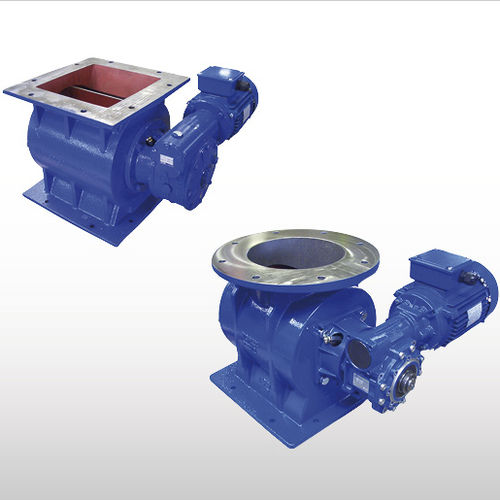
- Company
- Products
- Catalogs
- News & Trends
- Exhibitions
Pneumatic conveying rotary valve RV seriesfor foodfor plasticsfor pharmaceutical applications







Add to favorites
Compare this product
Characteristics
- Applications
- for pneumatic conveying, for bulk materials, powder, for food, for pharmaceutical applications, for plastics, for chemical products, recycling, for cement
- Type
- round-flange, square-flange
- Other characteristics
- ATEX, explosion-proof
Description
RV/RVR Rotary Valves are the ideal solution for controlled discharging and feeding of powdery or granular materials from silos, hoppers, pneumatic conveying systems, bag filter houses, or cyclones.
Description
RV Drop-Through Rotary Valves with square and RVR with circular inlet consist of a tubular cast iron or stainless steel casing, a horizontally mounted rotor with a certain number of V-shaped cross section compartments, a drive unit and a casing cover opposite the drive end.
Function
RV/RVR Rotary Valves are designed for maximum versatility in application. They are suitable for controlled discharging and feeding of powdery or granular materials from silos, hoppers, pneumatic conveying systems, bag filter houses, or cyclones.
Features
• Feed rates: 2.2 ~ 19.5 litres per revolution (0.08 ~ 0.7 cu ft per revolution)
• Working Temperature: -30 ~ 150 °C (-22 ~ 302 °F)
• Different drives for different rotation speeds
• Various materials and treatments available depending on material handled
• Maximum differential pressure: 0.2 bar (2.9 PSI)
Benefits
• Compatible with other WAMGROUP equipment thanks to WAM standard flanges
• Robust, compact design
• Easy access to all internal mechanical components
VIDEO
Catalogs
Rotary Valves RV-RVR Brochure
10 Pages
Related Searches
- WAMGROUP conveyor
- WAMGROUP conveyor for the food industry
- Feeder
- WAMGROUP industrial vibrator
- WAMGROUP electric drive conveyor
- Drag chain conveyor
- Relief valve
- WAMGROUP food conveyor
- WAMGROUP stainless steel conveyor
- WAMGROUP handling conveyor
- WAMGROUP modular conveyor
- WAMGROUP bulk material conveyor
- WAMGROUP screw conveyor
- WAMGROUP unloading conveyor
- Conveyor for the pharmaceutical industry
- Pneumatic vibrator
- Loading conveyor
- Pilot-operated relief valve
- Compact conveyor
- Concrete vibration motor
*Prices are pre-tax. They exclude delivery charges and customs duties and do not include additional charges for installation or activation options. Prices are indicative only and may vary by country, with changes to the cost of raw materials and exchange rates.





